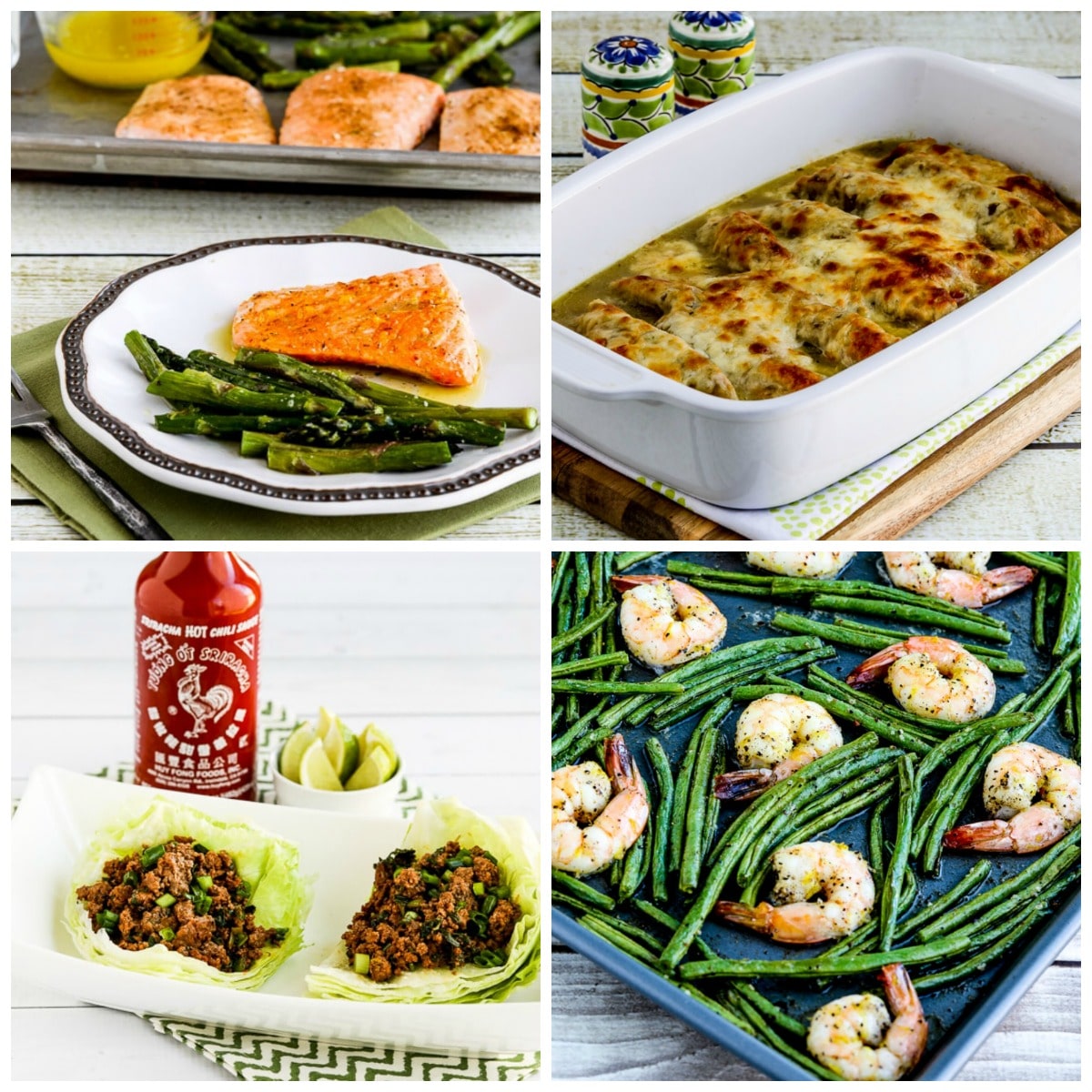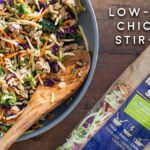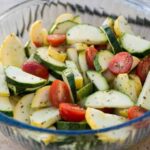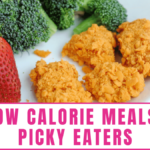Dive into a culinary adventure where simplicity meets deliciousness! Imagine crafting flavorful, satisfying meals with minimal effort and even fewer ingredients. This guide unveils the secrets to effortless low-carb cooking, showcasing a collection of recipes using five ingredients or less. Prepare to be amazed by the vibrant colors, tantalizing aromas, and incredible textures you can achieve with this streamlined approach to healthy eating. Forget complicated recipes and long grocery lists; we’re focusing on quick, easy, and undeniably tasty dishes that will revolutionize your low-carb lifestyle.
From quick weeknight dinners to satisfying snacks and elegant side dishes, this collection caters to every taste and schedule. We’ll explore a variety of cooking techniques, ensuring that even the busiest individuals can embrace low-carb eating without sacrificing flavor or convenience. Discover how to adapt your favorite high-carb recipes into low-carb masterpieces, learning clever substitutions that preserve taste and texture while significantly reducing carbohydrate intake. Prepare to unlock a world of culinary possibilities with these simple yet stunning recipes.
Low-Carb Vegetarian/Vegan Options (5 Ingredients or Less)
Embracing a low-carb lifestyle doesn’t mean sacrificing delicious and satisfying vegetarian or vegan meals. With a little creativity, you can create flavorful dishes packed with nutrients while keeping your carb intake low. These recipes showcase the versatility of simple ingredients to create hearty and healthy meals.
Two Vegetarian Low-Carb Recipes
The following recipes demonstrate how easily you can create satisfying vegetarian meals with minimal ingredients and preparation time. Both recipes focus on maximizing flavor and nutritional value while remaining low in carbohydrates.
Recipe 1: Creamy Avocado and Spinach Stuffed Mushrooms
Image Description: A close-up shot reveals six large mushroom caps, meticulously cleaned and filled with a vibrant green mixture of creamy avocado, wilted spinach, and a sprinkle of red pepper flakes. The mushrooms are arranged on a rustic wooden board, glistening slightly from the avocado, with the red pepper flakes adding a touch of fiery contrast.
Ingredients: 6 large mushrooms, 1 ripe avocado, 1 cup fresh spinach, salt and pepper to taste.
Instructions:
- Preheat oven to 375°F (190°C).
- Remove stems from mushrooms and roughly chop them.
- Sauté chopped mushroom stems in a pan until softened. This takes approximately 5 minutes.
- Mash avocado with a fork. Combine with sautéed mushroom stems and wilted spinach. Season with salt and pepper.
- Fill mushroom caps with avocado mixture. Bake for 15-20 minutes, or until mushrooms are tender and filling is heated through.
Estimated Cooking Time: 25-30 minutes
Recipe 2: Zucchini Noodles with Parmesan and Pesto
Image Description: A vibrant photograph showcases a bed of bright green zucchini noodles tossed with a generous amount of vibrant green pesto. Thinly shaved parmesan cheese is delicately scattered over the noodles, creating a beautiful contrast of textures and colors. The dish is presented in a shallow white bowl, highlighting its freshness and simplicity.
Ingredients: 2 medium zucchini, 2 tablespoons pesto, 1/4 cup grated Parmesan cheese, salt and pepper to taste.
Instructions:
- Use a vegetable peeler or spiralizer to create zucchini noodles.
- Toss zucchini noodles with pesto, Parmesan cheese, salt, and pepper.
- Serve immediately.
Estimated Cooking Time: 5 minutes
One Vegan Low-Carb Recipe
This recipe provides a simple yet nutritious vegan option that fits within a low-carb lifestyle. The focus is on maximizing flavor and texture with readily available ingredients.
Spicy Cauliflower Rice with Coconut Aminos
Image Description: A bowl brimming with fluffy, white cauliflower rice is presented. The rice is speckled with tiny flecks of red chili flakes, adding a visual hint of spice. A drizzle of dark, glossy coconut aminos is artfully arranged on top, creating a visually appealing contrast against the white cauliflower.
Ingredients: 1 medium head of cauliflower, 1 tablespoon coconut aminos, 1/2 teaspoon red pepper flakes, salt to taste.
Instructions:
- Rice the cauliflower using a food processor or grater.
- Sauté cauliflower rice in a pan over medium heat for 5-7 minutes, until slightly softened.
- Stir in coconut aminos, red pepper flakes, and salt. Cook for another minute, allowing flavors to meld.
Estimated Cooking Time: 10 minutes
Nutritional Information (per serving, approximate): Calories: 80-100, Protein: 3-4g, Fat: 3-5g, Carbohydrates: 7-9g, Fiber: 3-4g
Nutritional Comparison of Vegetarian and Vegan Recipes
The vegetarian recipes (stuffed mushrooms and zucchini noodles) offer slightly higher protein content due to the inclusion of cheese and mushrooms. The vegan cauliflower rice, while lower in protein, provides a comparable amount of fiber, contributing to satiety and digestive health. Both the vegetarian and vegan options are relatively low in carbohydrates, making them suitable choices for a low-carb diet. The specific nutritional values will vary depending on the ingredients used and portion sizes.
Adapting Existing Recipes to Low-Carb (5 Ingredients or Less)
Transforming beloved high-carb dishes into low-carb delights is easier than you might think. By strategically swapping ingredients, you can maintain delicious flavors while significantly reducing carbohydrate intake. This process often involves focusing on the core components of a recipe and replacing high-carb elements with their low-carb counterparts, resulting in satisfying and healthy meals. We’ll explore this process by adapting a classic pasta dish, highlighting key substitutions and their impact.
Adapting a Pasta Dish to Low-Carb
Let’s take a typical creamy tomato pasta dish as an example. This recipe usually relies heavily on pasta and perhaps cream, both high in carbohydrates. To create a low-carb version, we’ll replace these with ingredients that provide similar texture and flavor but with significantly fewer carbs. The resulting dish will be surprisingly satisfying, showcasing the versatility of low-carb cooking.
- Original Recipe (High-Carb): Creamy Tomato Pasta with pasta, canned tomatoes, cream, garlic, and parmesan cheese.
- Adapted Low-Carb Recipe (5 Ingredients or Less): Creamy Tomato Zoodles. This version substitutes zucchini noodles (zoodles) for pasta, reducing carbohydrates substantially.
- Ingredients: 2 medium zucchini (spiralized into noodles), 1 (14.5 ounce) can crushed tomatoes, 1/4 cup heavy cream, 2 cloves garlic (minced), 1/4 cup grated parmesan cheese.
- Instructions: Sauté minced garlic in olive oil until fragrant. Add crushed tomatoes and bring to a simmer. Stir in heavy cream and parmesan cheese. Add the zoodles and cook until heated through, about 2-3 minutes. Do not overcook the zoodles, as they can become mushy. Season with salt and pepper to taste.
- Serving Suggestions: Serve immediately as a light and flavorful main course. Garnish with fresh basil for an added touch of freshness and aroma. The vibrant red of the sauce contrasts beautifully with the pale green of the zoodles, creating a visually appealing dish.
Common High-Carb Ingredients and Low-Carb Alternatives
Understanding common high-carb ingredients and their low-carb alternatives is crucial for successful recipe adaptation. These substitutions often impact texture and flavor, but with careful selection, the overall culinary experience remains enjoyable.
- High-Carb Ingredient: Pasta. Pasta, a staple in many dishes, is predominantly carbohydrate. A single serving of pasta can contain a significant amount of carbohydrates. Low-Carb Alternative: Zucchini noodles (zoodles), shirataki noodles, or cauliflower rice. Zoodles offer a similar texture to pasta, shirataki noodles are nearly carbohydrate-free, and cauliflower rice provides a slightly different texture, suitable for dishes where a grain-like consistency is desired. The nutritional impact is a drastic reduction in carbohydrates and often an increase in fiber and micronutrients (in the case of zucchini and cauliflower).
- High-Carb Ingredient: White Rice. White rice is a refined carbohydrate, offering little nutritional value beyond energy from carbohydrates. Low-Carb Alternative: Cauliflower rice. Cauliflower rice provides a similar texture and can be used as a base for many dishes, offering fiber and vitamins. The nutritional impact is a reduction in carbohydrates and an increase in fiber and vitamins.
- High-Carb Ingredient: Potatoes. Potatoes, particularly white potatoes, are high in carbohydrates. Low-Carb Alternative: Cauliflower mash. Cauliflower mash offers a creamy texture similar to mashed potatoes, but with significantly fewer carbohydrates. The nutritional impact is a reduction in carbohydrates and an increase in fiber and vitamins.
Advanced Low-Carb Techniques (5 Ingredients or Less)

Mastering a few key cooking techniques significantly expands the possibilities of low-carb cuisine, allowing for delicious and nutritious meals with minimal effort. This section explores three advanced techniques, each offering unique benefits and challenges, while keeping ingredient lists refreshingly short.
Roasting Vegetables
Roasting vegetables at high temperatures brings out their natural sweetness and creates a delightful caramelization. This technique is ideal for low-carb cooking as it requires minimal added fat and enhances the flavor profile of vegetables without relying on high-carb sauces. The high heat promotes browning, developing complex flavors and textures. Nutrient retention can be high, especially if roasting times are carefully managed to prevent overcooking. However, some water-soluble vitamins might be lost during the cooking process.
Example Recipe: Roasted Asparagus with Garlic and Parmesan
Ingredients: 1 bunch asparagus, 2 cloves garlic (minced), 1 tbsp olive oil, 1/4 cup grated Parmesan cheese, salt and pepper to taste.
Instructions: Preheat oven to 400°F (200°C). Toss asparagus with olive oil, minced garlic, salt, and pepper. Spread on a baking sheet and roast for 12-15 minutes, or until tender-crisp. Sprinkle with Parmesan cheese during the last minute of cooking.
Grilling Meats and Fish
Grilling offers a fantastic way to enjoy lean protein sources while minimizing added fats and carbohydrates. The high heat of the grill creates beautiful grill marks, adding visual appeal and a smoky flavor to the dish. Grilling is relatively quick, making it ideal for weeknight meals. Nutrient retention is generally good, but some fat and moisture loss can occur, depending on grilling time and heat. Careful attention to temperature is crucial to prevent burning or drying out the food.
Example Recipe: Grilled Salmon with Lemon and Dill
Ingredients: 1 salmon fillet, 1 lemon (sliced), 1 tbsp fresh dill, salt and pepper to taste.
Instructions: Preheat grill to medium-high heat. Place salmon fillet on the grill, top with lemon slices and dill. Season with salt and pepper. Grill for 4-6 minutes per side, or until cooked through.
Stir-Frying
Stir-frying is a fast and efficient cooking method that works well with low-carb vegetables and protein. The quick cooking time helps to retain nutrients, and the use of minimal oil keeps the dish light. However, the rapid cooking process requires some skill to prevent burning or undercooking. It is essential to use a wok or large skillet to ensure even cooking and to work quickly.
Example Recipe: Shrimp Stir-fry with Broccoli and Garlic
Ingredients: 1 lb shrimp (peeled and deveined), 1 head broccoli (cut into florets), 2 cloves garlic (minced), 1 tbsp coconut aminos, 1 tbsp sesame oil.
Instructions: Heat sesame oil in a wok or large skillet over medium-high heat. Add shrimp and stir-fry for 2-3 minutes until pink. Add broccoli and garlic, stir-frying for another 3-5 minutes until broccoli is tender-crisp. Drizzle with coconut aminos and serve immediately.
Cauliflower Rice with Roasted Vegetables
This recipe demonstrates the importance of precise timing and temperature control in roasting, a crucial element in achieving optimal results in low-carb cooking. The combination of perfectly roasted vegetables and fluffy cauliflower rice creates a satisfying and flavorful meal.
Recipe: Roasted Broccoli and Cauliflower Rice
Ingredients: 1 head cauliflower (riced), 1 head broccoli (cut into florets), 1 tbsp olive oil, salt and pepper to taste, 1/4 cup nutritional yeast (optional).
Instructions: Preheat oven to 400°F (200°C). Toss riced cauliflower and broccoli florets with olive oil, salt, and pepper. Spread evenly on a baking sheet. Roast for 20-25 minutes, stirring halfway through, until cauliflower is tender and broccoli is slightly browned. Sprinkle with nutritional yeast for a cheesy flavor (optional). Careful monitoring of the oven temperature and cooking time prevents burning and ensures a tender yet slightly crisp texture. The cauliflower rice should be tender but not mushy, and the broccoli should have a pleasant char.
Embracing a low-carb lifestyle doesn’t have to mean sacrificing flavor or spending hours in the kitchen. This collection of recipes proves that delicious, healthy meals can be surprisingly simple. We’ve explored a range of options, from quick weeknight dinners and satisfying snacks to creative vegetarian and vegan choices. By mastering a few basic low-carb cooking techniques and smart ingredient substitutions, you can effortlessly transform your meals and embark on a journey towards a healthier, happier you. So, gather your ingredients, fire up your stove, and get ready to experience the joy of simple, delicious, and satisfying low-carb cooking!
Commonly Asked Questions
Can I adjust the portion sizes in these recipes?
Absolutely! The recipes provide guidelines, feel free to adjust ingredient quantities to suit your needs.
Are these recipes suitable for people with specific dietary restrictions beyond low-carb?
Many are adaptable. Always check individual ingredient labels for allergens and adjust as needed to accommodate specific dietary needs.
Where can I find substitutions for ingredients I don’t have on hand?
Many substitutions are possible! Consider using similar ingredients with comparable nutritional profiles. Online resources can offer helpful guidance.
How long can I store leftovers?
Leftovers should be stored properly in airtight containers in the refrigerator. The storage time will vary depending on the specific recipe; always check for any signs of spoilage before consuming.


